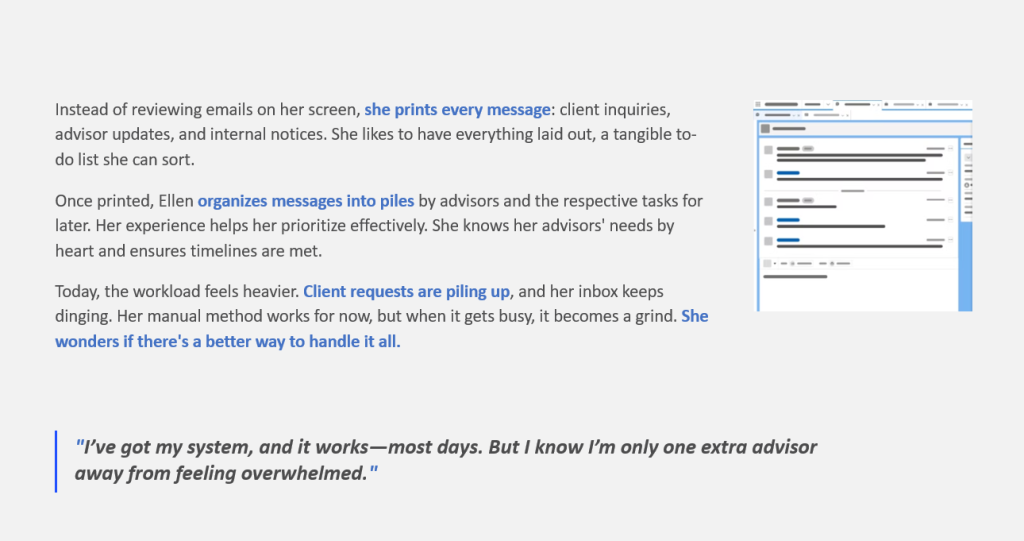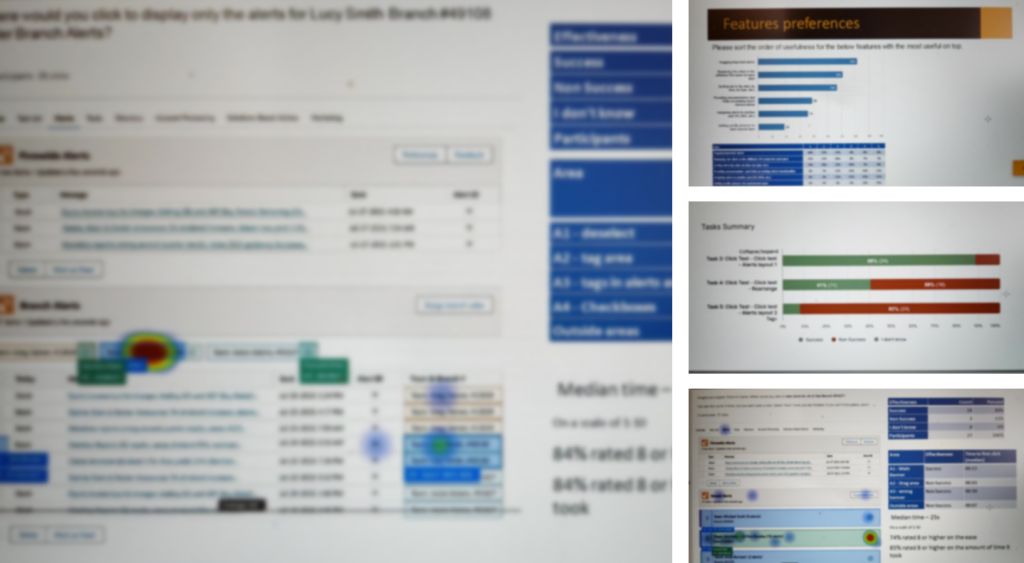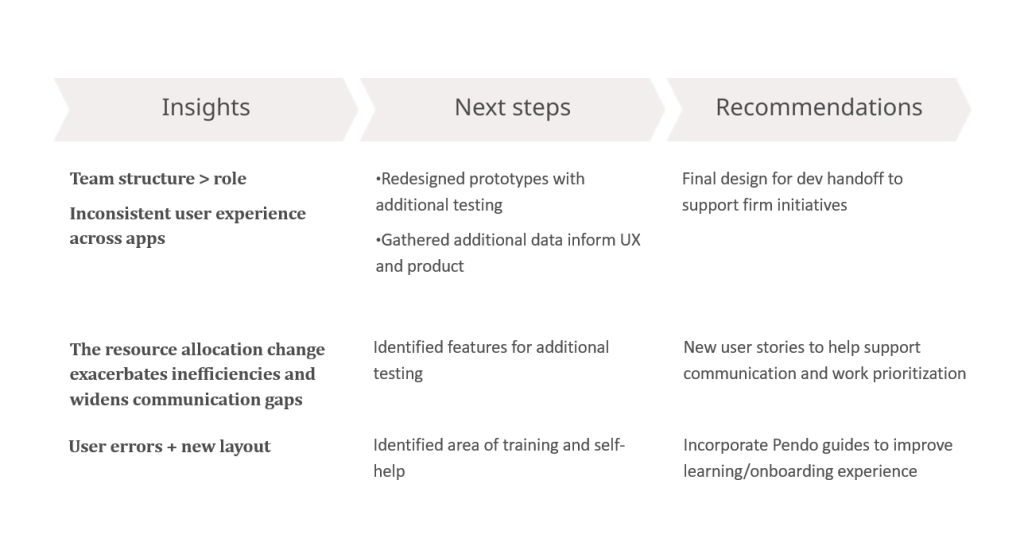Enhancing an Enterprise App to Empower Client-Facing Teams
Task
To redesign the notification app. I collaborated with the UX core team, HR, and 2 product teams, enabling seamless multi-branch management without VDI. By navigating complex constraints and aligning cross-functional efforts, I supported 2 multi-year firm-wide priorities while laying the foundation for a proactive UX roadmap that drove transformative impact and enhanced user efficiency.
The client is a Fortune 500 financial services firm, this company provides personalized investment advice and wealth management through a vast network of financial advisors and physical branch locations.
Branch team members managed multiple branches through Virtual desktop infrastructure (VDI), juggling different browser windows within a single desktop containing numerous applications.
To address this known pain point, a technical change was underway to remove VDI.
Additionally, several top firm priorities, including Salesforce CRM implementation and team restructuring, were ongoing. These multi-year initiatives represent a multimillion-dollar investment in a new ecosystem designed to enhance client support, impacting 20,000+ client-facing roles daily in how they serve their clients.
Redesign the home screen of the notification application that allows multi-branch team members to manage notifications seamlessly without VDI while navigating other digital changes.
Initially, the team was given approximately one month to develop a new design. As the lead researcher, my role was to provide the product and design teams with actionable insights that informed the design process.
Both the design and architecture were influenced by their future integration with Salesforce CRM and ongoing team restructuring. To establish a solid plan moving forward, the first step was to leverage existing resources and knowledge. I organized kickoff meetings and conducted a series of individual stakeholder interviews as needed.
The research journey began with stakeholder meetings to understand:
- Stakeholder Expectations
- Target users
- Business and Technical Context – What technical constraints or dependencies should we be aware of?
- How the notification system fits into the roadmap of the new ecosystem?

Although I was new to working with the three groups (VDI, notification app, and HR), who were already familiar with each other, I brought a fresh perspective. I connected the dots between them by bringing all the key players together in one room and gathering the following insights.
- Target Users: Align on who they are and outline a plan for reaching out to them.
- Technical: Weight in on UX patterns and design systems and the resources for implementation
- Time: Understand the current state and the roadmap of each project and ensuring we stay in sync with each other on timelines.
Due to the constraints that were identified, I got the green light for an additional two months for the UX team to deliver the project. I also defined the criteria for our target user groups and gathered the necessary information to start drafting a discussion guide for research.
Key research goals include:
- Identify target user groups and their work habits from the resource allocation change.
- Understand the nuances and scenarios of the notification system within the CRM ecosystem.
- Gather attitudinal feedback and pain points regarding the existing application, as well as preferences for potential changes.
- Evaluate the effectiveness of prototypes.
For the qualitative and attitudinal research, I conducted four focus groups with a mix of these user groups. This approach saved time and allowed for dynamic interactions among multiple roles, providing well-rounded insights. Some of the key takeaways from the focus group include:
- Overcoming Tool-Specific Ecosystem Challenges and Desired Workarounds:
- The new ecosystem posed significant challenges, with the amount of information shared across multiple apps creating inefficiencies. This highlighted the need for versatile product options and a seamless user journey.
- Current workarounds revealed a desire for features that prioritize work effectively.
- Addressing Product Knowledge and Communication Gaps:
- Users facing the most challenges with the tool often lacked product knowledge, leading to user errors.
- Different from what we expected, the users’ team structure rather than user role significantly influenced how they use the notification system.
- The new team structures demand extensive communication on roles and responsibilities.
Focus group discussions revealed that the enterprise tool was seen as part of a larger user journey rather than a standalone tool. The introduction of the new ecosystem added complexity, with teams seeking solutions to simplify their workflows and prioritize tasks effectively.

With the two firm priorities underway, users utilized the notification system differently based on their roles and team structures, resulting in varying preferences for the prototypes. The focus groups helped us narrow down from four prototypes to two. We identified patterns of user preference based on the team structure scenarios and the teams they support.

The insights led us to usability studies. Once we gathered the qualitative information, we were one step closer to the final prototype. Although we were on track with the research plan, it didn’t justify conducting 1-on-1 usability sessions. Instead, I decided to continue with a click test on UserZoom, accompanied by after-test questionnaires.
Click-Test Usability Study goals:
- Cross-check the preferences expressed by users in the focus groups with their actual behavior in the click test.
- Measure user success rate and time to click.
- Evaluate user perceived success and satisfaction.
- Assesse the design’s effectiveness.
This method is quick, concrete, and provides quantitative data on user behaviors. I administered the test for about two weeks, achieving a response rate of approximately 15% (40 users).

The result indicated a significant design opportunity.
In one of the prototypes, we observed a 90% failure rate in user clicks, highlighting significant challenges in locating or interacting with the intended elements and emphasizing the need for substantial usability improvements. Interestingly, an unintended area on the same prototype attracted nearly 100% user engagement, reflecting its perceived efficiency and user preference. Additionally, we captured valuable insights into users’ preferences for secondary features. These findings provided the product and design team with the confidence to finalize the prototype, which was subsequently handed off to the development team.
Beyond the notification app, the findings revealed broader insights into how team structures influence member behavior and the workarounds they create. We also identified that the new ecosystem introduced additional challenges in tool usability, underscoring the importance of offering versatile product options and ensuring a seamless user journey across platforms.

We had a final demo with the executive division leaders, and they were pleased with the insights and how we brought to the table.
Strategic Impacts
- By gaining a deeper understanding of the firm-wide priorities through actual stakeholder engagement, we comprehended the ripple effects of their roadmap and became more proactive in our UX and product roadmaps and priorities.
- These also efforts established a solid foundation and provided a detailed playbook for the portfolio to reference in the future.
Stakeholder collaboration Impacts
- Focused on working smarter, not harder! Along the way, we met with other UX teams and Design Thinking teams to leverage existing knowledge and form a communication channel for a better, more cohesive user experience across different platforms.
- Demonstrated that UX research is a strategic partner to product and business units.
Product/Team Impacts
- Invited collaboration with different UX and product teams to keep work honest and flexible for any expected changes
- Exceeded the original request by providing high-level direction for new features.
- Supported the ongoing development and adaptation of products for the months and years to come.
- 🤝Collaborate with Product Teams and SMEs: Teaming up with product teams and SMEs really helped us get up to speed with domain knowledge and find the right users. What seemed like an overwhelmingly daunting request became possible with their support.
- 💰Secure Buy-In: Individual discussions with team leads before broader presentations help secure buy-in.
- 😎Trust Your Gut: Trust your instincts about the amount of time needed for research. Share the research plan with your team to avoid surprises, always buffer time for unforeseen challenges but stay flexible for what makes sense.
- 🤯Leverage Existing Knowledge: Don’t reinvent the wheel! Design patterns and prior knowledge often exist, and someone can provide insights on how users feel about them. Emphasize synergy and leverage existing knowledge and resources for collective success.

